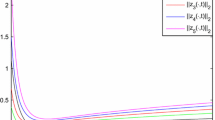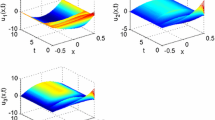Abstract
The authors investigate the passivity problem of switched coupled reaction-diffusion neural networks (SCRDNNs) with state and spatial diffusion couplings in this paper. For the considered network model, we derive an input strict passivity (ISP) criterion and an output strict passivity (OSP) criterion respectively by constructing an appropriate Lyapunov functional and exploiting Green’s formula and some other useful inequalities. Additionally, the authors also establish the relationship between exponential stability and OSP. Moreover, a sufficient condition for achieving synchronization of the considered SCRDNNs with hybrid coupling is presented according to the deduced OSP result and the relationship between exponential stability and OSP. Finally, the correctness of the derived theoretical conclusions is illustrated by two examples with simulation results.


Similar content being viewed by others
References
Watts D, Strogatz S (1998) Collective dynamics of small-world networks. Nature 393:440–442
Newman MEJ (2010) Networks: an introduction. Oxford University Press, New York
Freeman LC (2004) The development of social network analysis: a study in the sociology of science. Empirical Press, Vancouver
Strogatz SH (2001) Exploring complex networks. Nature 410:268–276
Hill D, Moylan P (1976) The stability of nonlinear dissipative systems. IEEE Trans Autom Control 21(5):708–711
Willems JC (1972) Dissipative dynamical systems. Part I: Gen Theory Arch Ration Mech Anal 45(5):321–351
Bevelevich V (1968) Classical network synthesis. Van Nostrand, New York
Xie L, Fu M, Li H (1998) Passivity analysis and passification for uncertain signal processing systems. IEEE Trans Signal Process 46:2394–2403
Calcev G, Gorez R, Neyer MD (1998) Passivity approach to fuzzy control systems. Automatica 34:339–344
Xu X, Zong G, Hou L (2016) Passivity-based stabilization and passive synchronization of complex nonlinear networks. Neurocomputing 175:101–109
Yao J, Guan ZH, Hill DJ (2009) Passivity-based control and synchronization of general complex dynamical networks. Automatica 45:2107–2113
Ye Z, Jia H, Zhang H (2016) Passivity analysis of Markovian switching complex dynamic networks with multiple time-varying delays and stochastic perturbations. Chaos Solitons Fractals 83:147–157
Kaviarasan B, Sakthivel R, Lim Y (2016) Synchronization of complex dynamical networks with uncertain inner coupling and successive delays based on passivity theory. Neurocomputing 186:127–138
Li C, Liao X (2005) Passivity analysis of neural networks with time delay. IEEE Trans Circuits Syst-II: Express Br 52(8):471–475
Xu S, Zheng WX, Zou Y (2009) Passivity analysis of neural networks with time-varying delays. IEEE Trans Circuits Syst-II: Express Br 56(4):325–329
Nagamani G, Ramasamy S (2016) Dissipativity and passivity analysis for uncertain discrete-time stochastic Markovian jump neural networks with additive time-varying delays. Neurocomputing 174:795–805
Thuan MV, Trinh H, Hien LV (2016) New inequality-based approach to passivity analysis of neural networks with interval time-varying delay. Neurocomputing 194:301–307
Song Q, Wang Z (2010) New results on passivity analysis of uncertain neural networks with time-varying delays. Int J Comput Math 87(3):668–678
Wu ZG, Shi P, Su H, Chu J (2011) Passivity analysis for discrete-time stochastic markovian jump neural networks with mixed time delays. IEEE Trans Neural Netw 22(10):1566–1575
Balasubramaniam P, Nagamani G, Rakkiyappan R (2011) Passivity analysis for neural networks of neutral type with Markovian jumping parameters and time delay in the leakage term. Commun Nonlinear Sci Numer Simulat 16:4422–4437
Chen Y, Wang H, Xue A, Lu R (2010) Passivity analysis of stochastic time-delay neural networks. Nonlinear Dyn 61:71–82
Song Q, Cao J (2012) Passivity of uncertain neural networks with both leakage delay and time-varying delay. Nonlinear Dyn 67:1695–1707
Samidurai R, Manivannan R (2015) Robust passivity analysis for stochastic impulsive neural networks with leakage and additive time-varying delay components. Appl Math Comput 268:743–762
Shen H, Wu ZG, Park JH (2015) Reliable mixed passive and \(H_{\infty }\) filtering for semi-Markov jump systems with randomly occurring uncertainties and sensor failures. Int J Robust Nonlinear Control 25(17):3231–3251
Shen H, Su L, Park JH (2017) Reliable mixed \(H_{\infty }\)/passive control for T-S fuzzy delayed systems based on a semi-Markov jump model approach. Fuzzy Sets Syst 314:79–98
Shen H, Zhu YZ, Zhang LX, Park JH (2017) Extended dissipative state estimation for Markov jump neural networks with unreliable links. IEEE Trans Neural Netw Learn Syst 28(2):346–358
Lu JQ, Ho DWC, Wang ZD (2009) Pinning stabilization of linearly coupled stochastic neural networks via minimum number of controllers. IEEE Trans Neural Netw 20(10):1617–1629
Lu JQ, Ding CD, Lou JG, Cao JD (2015) Outer synchronization of partially coupled dynamical networks via pinning impulsive controllers. J Franklin Inst 352:5024–5041
Zhong J, Lu JQ, Liu Y, Cao JD (2014) Synchronization in an array of output-coupled Boolean networks with time delays. IEEE Trans Neural Netw Learn Syst 25(12):2288–2294
Lu JQ, Zhong J, Huang C, Cao JD (2016) On pinning controllability of Boolean control networks. IEEE Trans Autom Control 61(6):1658–1663
Wang Y, Cao J (2007) Synchronization of a class of delayed neural networks with reaction-diffusion terms. Phys Lett A 369:201–211
Ren SY, Wu JG, Wei PC (2016) Passivity and pinning passivity of coupled delayed reaction-diffusion neural networks with dirichlet boundary conditions. Neural Process Lett. doi:10.1007/s11063-016-9557-3
Wang JL, Wu HN, Huang T (2015) Passivity-based synchronization of a class of complex dynamical networks with time-varying delay. Automatica 56:105–112
Wang JL, Wu HN, Huang T, Ren SY (2015) Passivity and synchronization of linearly coupled reaction-diffusion neural networks with adaptive coupling. IEEE Trans Cybern 45(9):1942–1952
Wang JL, Wu HN (2014) Synchronization and adaptive control of an array of linearly coupled reaction-diffusion neural networks with hybrid coupling. IEEE Trans Cybern 44(8):135–1461
Wang JL, Wu HN, Huang T, Ren SY (2016) Pinning control strategies for synchronization of linearly coupled neural networks with reaction-diffusion terms. IEEE Trans Neural Netw Learn Syst 27(4):749–761
Wang JL, Wu HN, Huang T, Ren SY, Wu J (2016) Pinning control for synchronization of coupled reaction-diffusion neural networks with directed topologies. IEEE Trans Syst Man Cybern: Syst 46(8):1109–1120
Wang JL, Wu HN, Huang T, Ren SY, Wu J (2016) Passivity and output synchronization of complex dynamical networks with fixed and adaptive coupling strength. IEEE Neural Netw Learn Syst. doi:10.1109/TNNLS.2016.2627083
Wang JL, Wu HN, Huang T, Ren SY, Wu J (2016) Passivity analysis of coupled reaction-diffusion neural networks with Dirichlet boundary conditions. IEEE Trans Syst Man Cybern: Syst, doi:10.1109/TSMC.2016.2622363
Wang JL, Wu HN, Huang T, Ren SY, Wu J (2016) Passivity of directed and undirected complex dynamical networks with adaptive coupling weights. IEEE Trans Neural Netw Learn Syst. doi:10.1109/TNNLS.2016.2558502
Zhao J, Hill DJ (2008) Passivity and stability of switched systems: A multiple storage function method. Syst Control Lett 57:158–164
Zhao J, Hill DJ (2008) Dissipativity theory for switched systems. IEEE Trans Autom Control 53(4):941–953
Hu MF, Cao JD, Yang YQ, Hu AH (2013) Passivity analysis for switched generalized neural networks with time-varying delay and uncertain output. IMA J Math Control Inf 30(3):407–422
Lian J, Wang J (2015) Passivity of switched recurrent neural networks with time-varying delays. IEEE Trans Neural Netw Learn Syst 26(2):357–366
Li N, Cao J (2016) Passivity and robust synchronisation of switched interval coupled neural networks with time delay. Int J Syst Sci 47(12):2827–2836
Xu BB, Huang YL, Wang JL, Wei PC, Ren SY (2016) Passivity of linearly coupled neural networks with reaction-diffusion terms and switching topology. J Franklin Inst 353:1882–1898
Xu BB, Huang YL, Wang JL, Wei PC, Ren SY (2016) Passivity of linearly coupled reaction-diffusion neural networks with switching topology and time-varying delay. Neurocomputing 182:274–283
Kannan R, Krueger CK (1996) Advanced analysis, chapter 3: Dini derivatives. Springer, New York
Niculescu SI, Lozano R (2001) On the passivity of linear delay systems. IEEE Trans Autom Control 46:460–464
Lu JG (2008) Global exponential stability and periodicity of reaction-diffusion delayed recurrent neural networks with Dirichlet boundary conditions. Chaos Solitons Fractals 35:116–125
Acknowledgements
The authors would like to thank the Associate Editor and anonymous reviewers for their valuable comments and suggestions. This work was supported in part by the National Natural Science Foundation of China under Grants 11501411, 61503010, 61403275 and 11401018, in part by the Natural Science Foundation of Tianjin, China, under Grant 15JCQNJC04100, and in part by the Aeronautical Science Foundation of China (No.2016ZA51001).
Author information
Authors and Affiliations
Corresponding author
Rights and permissions
About this article
Cite this article
Huang, Y., Ren, S. Passivity and Passivity-Based Synchronization of Switched Coupled Reaction-Diffusion Neural Networks with State and Spatial Diffusion Couplings. Neural Process Lett 47, 347–363 (2018). https://doi.org/10.1007/s11063-017-9651-1
Published:
Issue Date:
DOI: https://doi.org/10.1007/s11063-017-9651-1




